On Thursday, October 11th Dr. Alan Reid lead a walk around UFV’s D Building “swamp” as part of the Faculty of Science’s, greenSPEAK Series. His talk was an effort to make those of us in attendance ‘plant nerds’. We gathered at the First Nations’ spindle whorl and began our tour from there.
Thank you to Patrick Harrison, Chair of the Centre for Sustainability for his detailed notes of our walk.
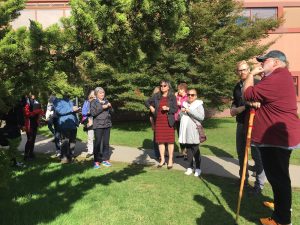
Our first ‘encounter’ was near the spirit circle with Juniperus scopulorum (Family Cupressaceae), Prince of Wales Juniper. This juniper is native to North America and ranges from Alaska to the Sierra Nevada. First year cones are blue, turning to black in the second year and becoming fleshy. Gin and oil of wintergreen are produced from these cones.
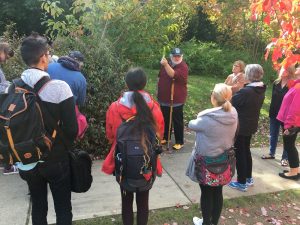 We then strolled down the hill toward D Building. At the periphery of the pond to the east of D Building, we observed the native plant Snowberry, Symphoricarpos alba in the plant Family Caprifoliaceae (Honeysuckle). The berries start out pink and then turn white as they mature. It’s a my that more berries means a harsher winter is coming. In that cluster of plants was another native: Cascara (Rhamnus purshiana in the plant Family Rhamnaceae). The plant flowers in mid-March and the berries appear in mid-June. The bark has been used as a tea by First People as an emetic. Purshia was a Jesuit priest who was an early visitor to North America. This plant is an outlier in this area. The leaves are wavy when viewed from the side.
We then strolled down the hill toward D Building. At the periphery of the pond to the east of D Building, we observed the native plant Snowberry, Symphoricarpos alba in the plant Family Caprifoliaceae (Honeysuckle). The berries start out pink and then turn white as they mature. It’s a my that more berries means a harsher winter is coming. In that cluster of plants was another native: Cascara (Rhamnus purshiana in the plant Family Rhamnaceae). The plant flowers in mid-March and the berries appear in mid-June. The bark has been used as a tea by First People as an emetic. Purshia was a Jesuit priest who was an early visitor to North America. This plant is an outlier in this area. The leaves are wavy when viewed from the side.
 Walking along the walk on the east side of D Building, we observed seven Dawn Redwoods, Metasequoia glytostroboides. The needles are feathery and deciduous. One distinct characteristic is that the branches come out of a hollow (an ‘armpit’ in the stem). The Dawn Redwoods is a relic from the past.
Walking along the walk on the east side of D Building, we observed seven Dawn Redwoods, Metasequoia glytostroboides. The needles are feathery and deciduous. One distinct characteristic is that the branches come out of a hollow (an ‘armpit’ in the stem). The Dawn Redwoods is a relic from the past.
Stewartia (Stewartia monodelpha, Family Theaceae, the tea family) grows from Georgia to Tennessee and in Korea. The oil that can be squeezed from the flowers is a very fine oil that can be used in watches as it won’t gum up the ‘works’ as regular motor oil does. Stewartia was named by Linnaeus to honour John Stuart, 3rd Earl of Bute. Unfortunately, Linnaeus was given the wrong spelling in transcription and thus spelled the genus Stewartia. It grows in the Appalachian Mountains and Korea. The large white flowers appear June through August when few other trees are in flower. The Stewartia has orange bark.

In amongst the Dawn Redwood is the native Western (Pacific) Yew (Taxus brevifolia in the Family Taxaceae). The terpine taxol is extracted from the bark and used for some treatments of ovarian cancer.
A mountain ash (Sorbus acuparia) nearby carried orange-red berries, is native, and is drought tolerant, which is necessary for the UFV campus, as there is no irrigation system on campus.
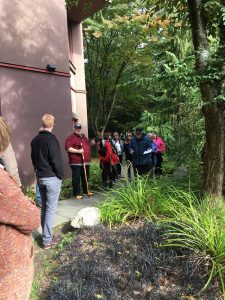 Continuing along the walkway, a Zelkova serrata was observed. This is known as a Russian Elm (not to be confused with Ulmus americus, the native elm). This elm is not susceptible to the Dutch Elm Disease as is the native elm. Just down the walkway was a ‘cousin’ to the Russian Elm known as Sicilian Elm, a rather small shrub. The Sicilian Elm. It can be distinguished from Russian Elm by the sandpaper like feel to the leaves.
Continuing along the walkway, a Zelkova serrata was observed. This is known as a Russian Elm (not to be confused with Ulmus americus, the native elm). This elm is not susceptible to the Dutch Elm Disease as is the native elm. Just down the walkway was a ‘cousin’ to the Russian Elm known as Sicilian Elm, a rather small shrub. The Sicilian Elm. It can be distinguished from Russian Elm by the sandpaper like feel to the leaves.
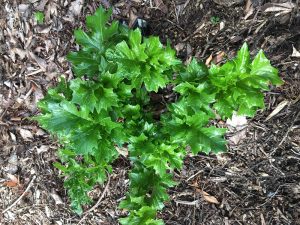
Tucked along one of the walls of D Building is a rather unique plant Acanthus spinosa (Bear’s Breech), known to be the inspiration for Greek corithean columns. It has brown, purple flowers with barbs and hooks on the stem. When the envelop to D Building is worked on next summer, Dr. Reid has recommended that these plants be dug up during construction and saved as they are rather rare. A. mollis is the better-known species of Acanthus.
Across from the Acanthus is a delightful example of Bald Cypress (Taxodium distichum). Depending on where this plant growths, it may or may not produce aerial prop roots. The needles are braided and thus distinguishes it from Dawn Redwood. It also does not have ‘armpits’. The Bald Cypress is native to Louisiana, Georgia, Carolinas, and Virginia.
Next to the Bald Cypress was a native to North America, Abies concolor, White Fir. You can tell a fir from a spruce by doing a handshake with a branch: Firs are friendly and spruce are spikey.
Aspirin was first patented by Bayer. For years only Bayer could produce aspirin until this was overruled in a court case. Aspirin is a derivative of Salicylic Acid, which comes from willows. One species spotted was Salix oranicum Basket Willow. It has fairly large stipules (little leaf-like projects) surrounding the buds. These offer protection to the newly formed bud. Willow buds have only one bud scale.
 Sedges and grasses were observed along the walkway. Sedges have edges and rushes are round (stems), and grasses have nodes from top to ground. Among the grasses was a peony. One of the more interesting grasses was a Zebra Grass (Mischanthus sinensis), so called because of the striped effect induced by inoculating with an ascomycete fungus.
Sedges and grasses were observed along the walkway. Sedges have edges and rushes are round (stems), and grasses have nodes from top to ground. Among the grasses was a peony. One of the more interesting grasses was a Zebra Grass (Mischanthus sinensis), so called because of the striped effect induced by inoculating with an ascomycete fungus.
At the south end of D Building was a Red Osier Dogwood (Cornus stolonifera in the Family Cornaceae). One unique feature of dogwood leaves is that one can pull apart the leaf blade and the veins will remain attached by ‘cottony’-like threads. Osier is a designation for plants that have multiple stems that arise from the same location at the soil level.
Next to the dogwood was Nine Bark Diabolo (Physocarpus opulifolium mono) in the Rose Family. This variety has dark purple leaves, but if stressed, the leaves will return to the more natural green foliage.
Lavender lines the south wall of D Building. Sniff lavender for relaxation.
Round the end of D Building, one finds several Hop Hornbeam trees (Carpinus caroliniana). The Hop Hornbeam leaves have parallel veins, and the tree derives it name from the green flowers that look similar to hops.
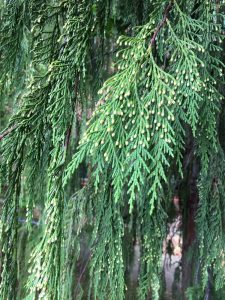
Amongst the Hop Hornbeam is a native Yellow Cedar (Chamaecyparis nootkantensis). This tree belongs to the Family Cupressaceae. The female cones (seed cones) are round because of the peltate scales. Yellow cedar was used by the First People rather than another native species, Red Cedar, because it has a finer grain and is easier to create details. Neither Red Cedar nor Yellow Cedar is a true cedar. Only trees in the genus Cedrus are considered true cedars (e.g. Altas Cedar of the Atlas Mountains in Morocco or the Cedar of Lebanon).

Surrounding the metal linked fence at the south end of B Building is Firethorn Pyracanthus X mohave). The genus name Pyracanthus says the same thing: Pyra = fire and canthus = spike. This plant has the typical flowers found in the Rose Family (Rosaceae). This particular Firethorn is known as the Mohave Firethorn. This plant is excellent for preventing intruders into a property because of the stout thorns. This plant is resistant to fire blight. It was developed by the U.S. Arboretum (P. coccinea X P. koidzumii).
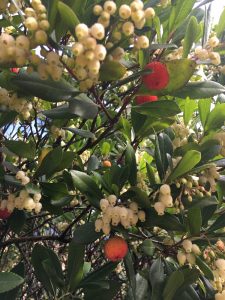
Just to the west of the Firethorn is Arbutus unedo known as the Strawberry Tree since the fruit produced is like a red strawberry. When the fruit ripens to a bright red, it is ready to eat. This tree flowers in the spring and in the fall. This tree has a disjunct distribution from the Mediterranean Sea to Ireland. It is related to our native species of Arbutus (Arbutus menziesii). The urn-shaped flowers place this genus in the Family Ericaceae (Heath Family).
Next to the Arbutus was a Corsican Pine (Pinus nigra). Most pines on campus are of this species as it is very drought resistant and UFV does not have an irrigation system.
Turning the corner and heading north on the walkway on the west side of B Building, one finds the Sweet Gum tree (Liquidambar styraciflua). The leaves can be mistaken for a maple leaf with its pointed leaves. However, maple leaves are opposite, while Sweet Gum has alternate branching. Maples have twin winged samaras for developed fruit, while Sweet Gum produces round ball-like fruits.
Along the roadway on the opposite side of road from the Sweet Gum is Acer rubrum freemanii (Aceraceae) called Freeman’s Red Maple. This species is patented material and cannot be tissue-cultured or reproduced by anyone. This tree has self-shedding lower branches, which makes it a great boulevard tree.
Moving northward to the west entrance of B Building, is found Rhododendron var. Cynthia, a large deciduous Rhodo which has pink flowers.
At the island of trees in front of the main entrance to campus (between A and B Building) is found the Norway maple with its fairly large lobed leaves and twin samaras. This tree can be determined from North American species of maple as European species have a white latex at the base of the petiole when plucked from the tree, while native North American maples do not.
Looking towards the Abbotsford Entertainment Centre, one can see a tree with vary large leaves, the Paulownia tree (Paulownia tomentosa, Family Scrophulariaceae). This tree is known as the Foxglove Tree or Princess Tree. This tree has very large lavender flowers.
We thank Dr. Alan Reid for taking time out to lead this walk. Future walks will be taking place.



